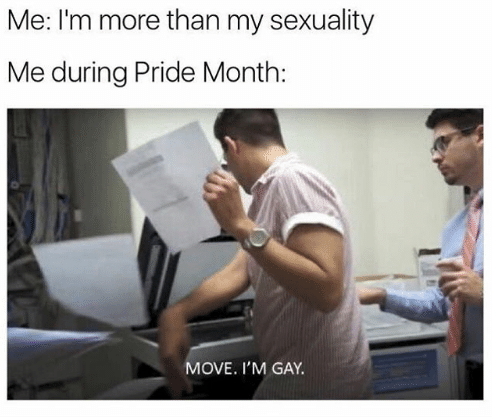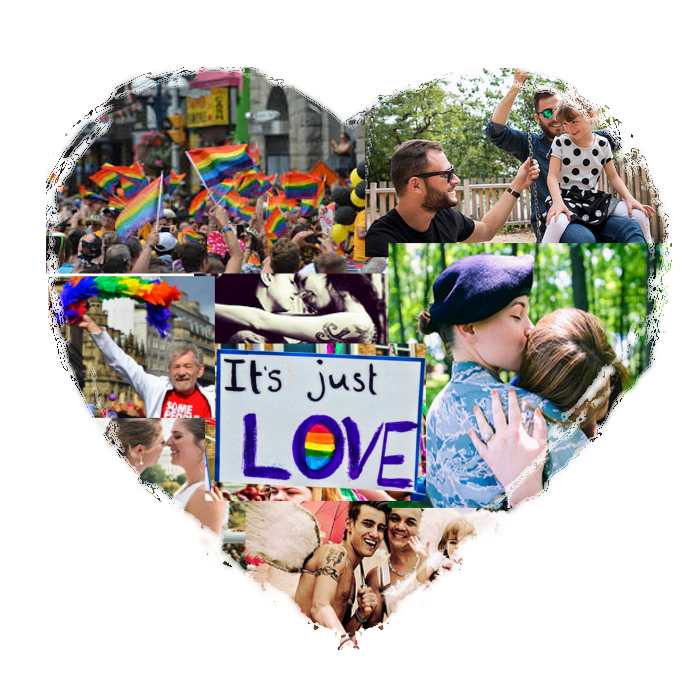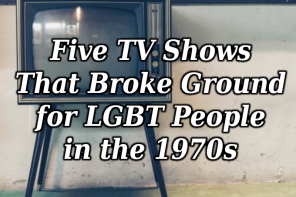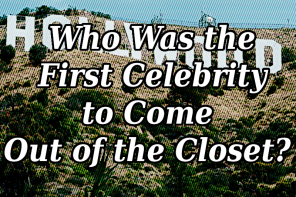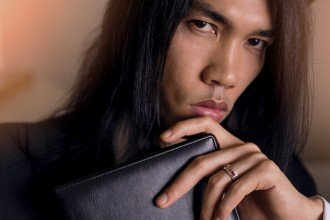Marriage equality. Legal protections. Widespread acceptance. Representation in mainstream media and entertainment. With all of the legal and cultural advances made in the last few years, is celebrating Gay Pride still important? Are Pride parades honoring our shared history or have they devolved into a cliched orgy of over the top costumes and irreverent displays? Are they now doing more harm than good?
Is the party and celebratory atmosphere used to promote Gay Pride month – and, in particular, gay pride parade events held in cities – nothing more than a way for cities and companies to make money off the LGBT community? Or is it a time when people simply feel they can be more open and show signs of union and solidarity? If that means buying a rainbow button, using the Pride Month filter on Insta or hitting up a pride party or two, what’s the harm in that?
These are just some of the questions being asked by members of the LGBT and ally communities as pride parades and parties swing info full gear.
Let’s be Clear About What Pride is All About
Before we go any further, I want to be sure we all know why we go through Pride Month in the first place. It’s not just about being out and queer or out and gay and out or … well, anything you want to be. It’s about the real brick-throwing struggle the gay community has gone through to get to where we are today.
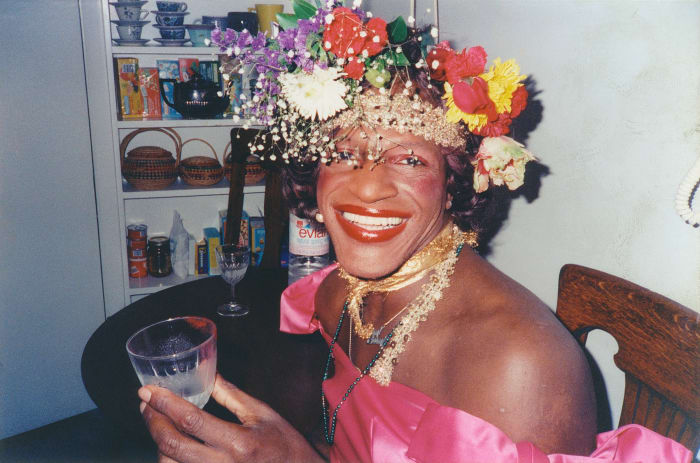 Marsha, Marsha, Marsha (source)
Marsha, Marsha, Marsha (source)
If you don’t already know who this is, you’re in for a treat. Meet Marsha P. Johnson. The P stands to ‘Pay It No Mind’ and she is a big reason why we even get to have debates about whether Pride Parades are important.
Marsha was a neighborhood eccentric and known as a ‘holy’ woman to those who believed her charisma and charm delivered warmth and healing energy. To others she was known as a driven, outspoken and sometimes intimidating woman who would brush off (hence the ‘Pay it no mind’ middle name) problems in favor of simply getting back to her life.
In the 60s, the Stonewall Inn was one of the few bars where LGBT people could come together – either singly or as couples – and just relax and have fun. State laws meant that, as an openly gay establishment, it could not receive a liquor license. Instead, it operated as an illegal saloon protected by mob interests. Still, police raids were fairly common, under the guise of serving liquor without a license.
Johnson said she had been one of the first drag queens to begin frequenting the bar once they had begun allowing women. Previously the bar had been only for men but they relaxed their rules and began allowing in anyone who identified as gay.
While often credited with literally starting the riot and “throwing the first brick”, Johnson clarified that she had shown up at the bar after the riot began and the bar was already on fire. Still, she jumped into the fray and became one of the more vocal and dramatic activists in the early hours and days of the movement.
In the book Stonewall: The Riots that Sparked the Revolution, author David Carter reports that on the first night, Johnson was seen throwing a shot glass at a mirror and screaming “I got my civil rights”. On the second night of the riots, she climbed up a lamppost and threw a heavy object onto the windshield of a police car.
While she may not have thrown the first brick, it has become a cultural legend of sorts that has a grain of truth. First brick or not, she spent the rest of her life openly and forcefully demonstrating, marching and advocating for the entire LGBT community.
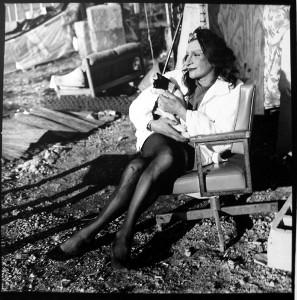
Sylvia Rivera (source)
While Marsha has become the face of the original uprising, the fact is that the story – our story – has so many heroes and examples of ‘average people’ doing amazing things. Sylvia Rivera, for example, is another well-known activist. She was a close friend of Martha P. Johnson and worked with her to create the Street Transvestite Action Revolutionaries (STAR). The group is dedicated to supporting and helping young trans women of color and drag queens who are vulnerable due to homelessness.
Born Ray Rivera, the future activist was from New York City and grew up an orphan after she was abandoned by her father and her mother committed suicide. Raised by her Venezuelan grandmother who disapproved of her grandchild’s effeminate behavior and penchant for wearing makeup, Rivera found herself homeless by the age of 11. She began working as a prostitute and was eventually taken in by a local community of drag queen who renamed her Sylvia and gave her the support she needed to find her identity and place in the world.
Like Johnson, Rivera is rumored to have thrown one of the first bottles during the riot. The crowd at the uprising was, in fact, 70 percent African American and Puerto Rican. A significant number of those people were also trans men and women. it’s a point Rivera would bring up at every opportunity. “We were the frontliners,” Rivera told interviewers. “We didn’t take no shit from nobody. We had nothing to lose.”
Rivera spent her entire life advocating for the LGBT community while wrestling with substance abuse and addiction issues. She is an LGBT icon who dipped in and out of homelessness, poverty and depression for much of her life. While her story is sometimes a sad one, it’s also a testament to the power and strength of those who were willing to risk what little they had left in order to live a life out in the open.
Pride Then vs. Pride Now
There are those who say that today’s Pride parades and celebrations are simply too over the top, too silly and too irreverent to even be linked (much less compared) to the original Pride movement.
It’s true, Pride Parades now feature plenty of over the top displays and comedic flair. But most – if not all – Pride Parades also feature groups from local support agencies, churches, outreach centers and other LGBT friendly organizations. Same sex families, trans men and women and non-binary groups have also become increasingly represented in these parades.
Today’s pride Parades may be different and, in some cases, outlandish, but they’re all about one thing: celebrating the LGBT culture and history and, yes, even having some fun.
Certainly, there are some parade marchers and attendees who push the envelope or even set out to be offensive and in your face. It could be they are naturally flamboyant and use Pride Parades as a place to really let loose. It could be they have been in the closet for years and this is the first time they’ve been able to be themselves in public. Or it could be they’re just obnoxious – after all, assholes come from every walk of life.
While these over the top displays may be the ones most often shown in news slideshows or on Buzzfeed roundup lists, that doesn’t mean they reflect the most important parts of Gay Pride. All that flamboyant display and in-your-face noise is just window decoration. And while it had its place, there many local LGBT organizations are working to return their local pride parades to their roots.
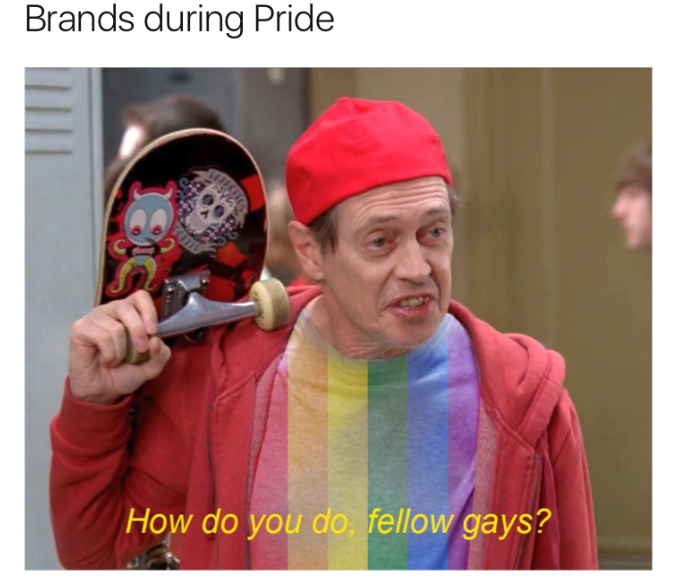 (source)
(source)
Money, Money, Money
There has been plenty of criticism about the commercialization of Gay Pride month. Several companies have jumped on the bandwagon to make changes to their branding and marketing in order to appeal to the LGBT community and their allies.
- McDonald’s – McDonald’s added the rainbow flag colors to the back of their French fry covers.
- Nike / Converse – In 2017, Nike launched its BETRUE 2017 line of products in clear support of the LGBT community. The new line was part of their larger Equality campaign which promoted “the passion and pursuit of sport by all athletes.” Converse also launched a line of colors in vibrant, rainbow colors with net proceeds being donated to the It Gets Better Project and the Happy Hippie Foundation.
- Skittles – Skittles went the other way in terms of adding rainbows and chose instead to “give the rainbow back” and created bags of their signature rainbow candy devoid of any color. White bags with plain line drawings and candies that were simply white with a black ‘s’ on them.
So, does all this cashing in mean that Pride Parades and other events have just become another part of the capitalist machine?
Yeah, kinda. But that’s okay.
Look, going mainstream and achieving culture acceptance means that we’ve sold the public on the fact that having a different sexual orientation, being transgender and exploring the wider meaning of the word gender (looking at you, non-binary and non-conforming humans!) isn’t something to be ashamed of.
The trade off in all that acceptance is that companies will absolutely pounce on that wave of feel-good love and look to make a few bucks on it. Maybe they’ll use an LGBT spokesperson, team up with a specific LGBT group, air LGBT friendly commercials or just slap a rainbow on their logo somewhere. Whatever they do, it’s taking a public stand in support of the LGBT community.
For every Gay Pride campaign, there are people who swear they’ll boycott and never set foot in that place, buy that product or use that service. That means that now, when a large company goes ahead with a Gay Pride campaign, that means they’ve realized the benefit of coming out in support of Gay Pride outweighs the potential blowback.
Saving Pride
Pride remains important for several reasons. It’s important to honor and celebrate the people who worked so hard and sacrificed so much in order to achieve equality and acceptance. Parades and other events are often also the first chance young LGBT people have to not only be who they are and dress or present in any way they want, it’s also likely the first time they’ve been surrounded by people who are just like them or those who support without judgement or ridicule.
Pride parades and events are also important because they show how far we’ve come. From the overtly violent and aggressive demonstrations of the late 1960s and 70s and the AIDS epidemic of the 1980s to the party and carnival-like atmosphere we often see today.
In almost any large city where a parade takes place, take a minute to look around at all of the different people in attendance. Chances are you won’t have to look long before you see an older man or woman, watching the festivities with a smile. For older members of the LGBT community, these events offer a moment of reflection and nostalgia.
While Pride Parades remain an important part of the LGBT community, they are not without their problems. In many cities, local LGBT organizations have begun to protest and demonstrate against parades.
This isn’t about catering to crazy demands or dealing with people who are simply hell bent on finding fault with things. While the specific demands of groups vary, they do have three main issues in their cross-hairs:
- Including trans women of color and indigenous people in decision-making roles
- Ending the endorsement of law enforcement agencies / working with law enforcement to create and maintain and positive, honest and effective sense of community with the LGBT and ally communities
- Barring corporations that have a negative impact on the LGBT+ community
Is Pride perfect? No. The LGBT community has overcome some of the first hurdles any minority group needs to overcome – finding equality and acceptance. Now it’s time to look inward and ensure we are practicing what we preach. This is the only way to keep Pride relevant and worth preserving for generations to come.
Infighting among different groups within the LGBT community has led to a fractured community, but still one with a common history and ties that are worth saving – and strengthening. This can only be done if we come together, listen to each other and try to understand what each group can bring to the festivities. That means hearing what they have to say about the perspective they bring to the conversation as well as ways that make the movement increasingly inclusive.
Even looking at the main criticisms of the events can offer some insight into where changes need to be made.
- The Commercialization of Pride Events / Merch – There’s a fine line between marketing pride in a positive way and launching a full-out cash grab. I’ve got no problem with companies that want to cash in a bit on Gay pride month but let’s keep it classy. Calling out companies that wave the flag publicly while not supporting the LGBT community the rest of the year is a great place to start. Support the brands, local businesses and merchants that support LGBT Pride all year round, not just in June.
- Money, Money, Money – Companies that dedicate part of their profits to LGBT friendly organizations and causes are well worth supporting. But that isn’t the only way profit can be used for something positive. Profits from local businesses or even the city can be funneled into supporting care and outreach to vulnerable members of the LGBT community, to public forums for addressing issues within the community and even to other LGBT themed events throughout the year to bring about a better sense of community.
- Over the Top Parade Displays – Sure it’s fun to walk around in a jumpsuit with a bunch of dildos attached to it but, let’s be honest, that’s not the best way to acknowledge the men, women and non-identifiers who paved the way. When you’re participating in Pride, take a moment to ditch the dildo suit and raise a glass.
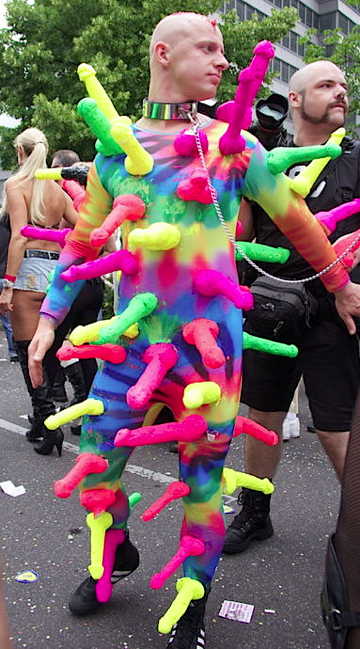
That means you, Tad (source)
Pride is not only still important, it needs our help. The LGBT community has become increasingly fractured with various groups engaging in some sort of pissing contest about who has it worse or who is more overlooked and under-represented. How about we stop fighting, start listening and get to work doing what we do best – bringing each other up instead of pulling each other down. Who’s going to save Pride? You. Me. Us.

